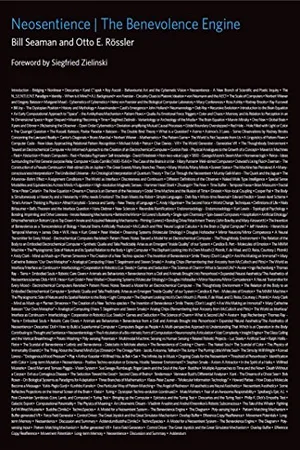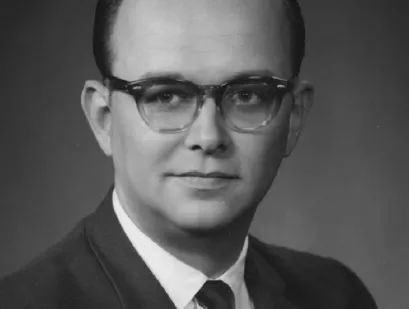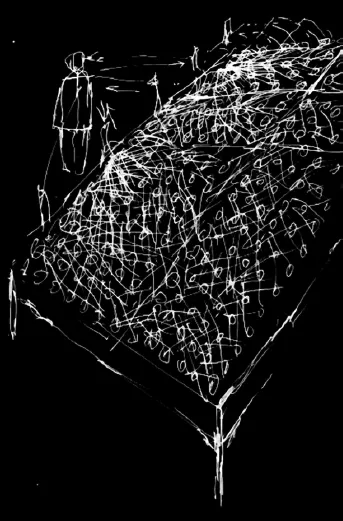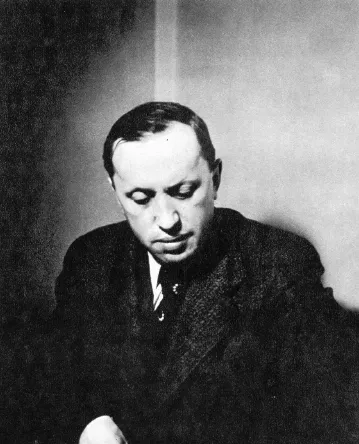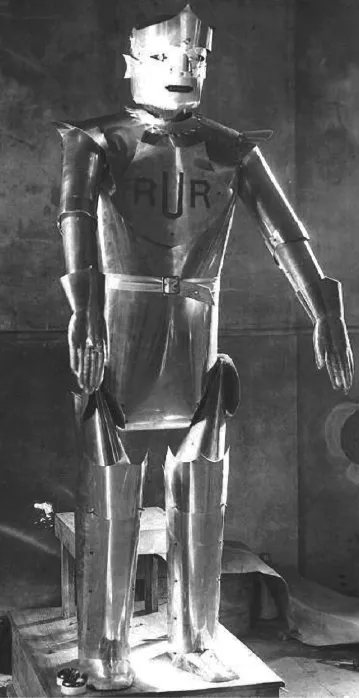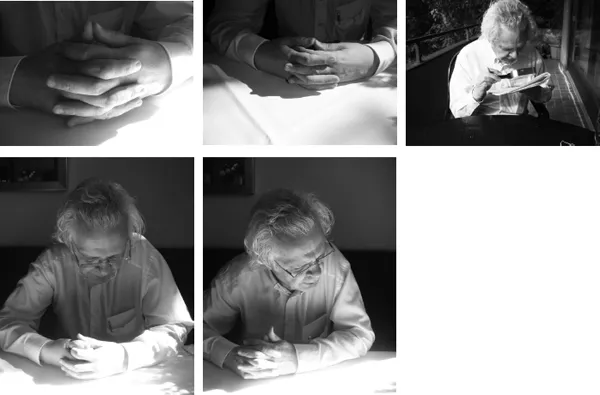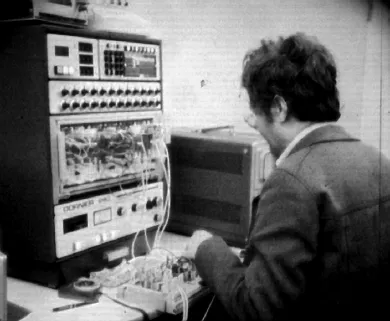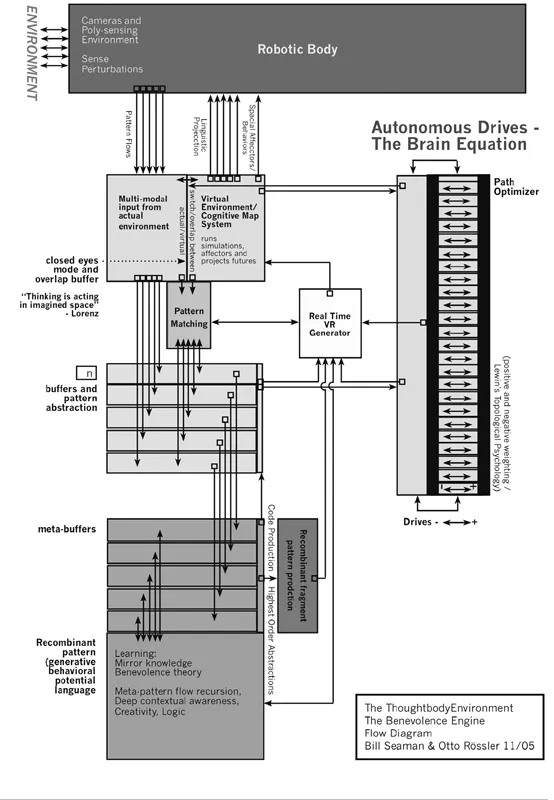![]()
Microchapters
Introduction - Bridging
The idea of building a model for a Neosentient computer and related robotic systems is both an exciting and daunting task. In order to model and ultimately build such a device one seeks to borrow important operative concepts and processes from the body and re-understand them in the context of a mechanism that is not human in nature. The use of micro-chapters in the book is a multi-perspective approach to this project - an answer that asks questions.
Hugh Everett:
The model nature is quite apparent in the newest theories, as in nuclear physics, and particularly in those fields outside of physics proper, such as the Theory of Games, various economic models, etc., where the degree of applicability of the models is still a matter of considerable doubt. However, when a theory is highly successful and becomes firmly established, the model tends to become identified with “reality” itself, and the model nature of the theory becomes obscured. The rise of classical physics offers an excellent example of this process. The constructs of classical physics are just as much fictions of our own minds as those of any other theory we simply have a great deal more confidence in them. It must be deemed a mistake, therefore, to attribute any more “reality” here than elsewhere.1
Hugh Everett III, courtesy of Mark Everett.
Nonlinear
Ingredients: intuition, talking, and friendship.
Descartes
Descartes was the first person to describe the body as a machine.
Electrochemical “field” and linked robot, Seaman 2005.
Karel Čapek
In 1923, Karel Čapek used the term “robot” which was a Czech word meaning worker, in a new context in his play R.U.R. (Rossum’s Universal Robots).
Karel Čapek vefotografii, Jiří Opelík. Praha: SNK, 1991, p. 157. Public domain.
The RUR robot which appeared in an adaption of Czech author Karel Capek's Rossum's Universal Robots.
The play is laid out on an island somewhere on our planet, and on this island is the central office of the factory of Rossums's Universal Robots. “Robot” is a Czech word meaning “worker.” When the play opens, a few decades beyond the present day, the factory had turned out already, following a secret formula, hundreds of thousands, and even millions of manufactured workmen, living automats, without souls, desires or feelings. They are high powered laborers, good for nothing but work. There are two grades, the unskilled and the skilled, and specially trained workmen are furnished on request.
When Helena Glory, president of the Humanitarian League, comes to acertain what can be done to improve the condition of those overspecialized creatures, Harry Domin, the general manager of the factory, captures her heart and hand in the speediest courting on record in our theatre. The last two acts take place 10 years later. Due to the desire of Helena to have the robots more like human beings, Dr. Gall, the head of the physiological and experimental departments, has secretly changed the formula, and while he has partially humanized only a few hundred, there are enough to make ringleaders, and a world revolt of robots is underway. This revolution is easily accomplished, as robots have long since been used when needed as soldiers and the robots far outnumber human beings.
The rest of the play is magnificent melodrama, superbly portrayed, with the handful of human beings at bay while the unseen myriads of their own robots close in on them. The final scene is like Dusany on a mammoth scale.
Then comes the epilogue, in which Alquist, the company's builder, is not the only human being left on the island, but also the only one left on earth. The robots have destroyed the rest of mankind. They spared his life because he was a worker. And he is spending his days endeavoring to discover and reconstruct the lost formula. The robots are doomed. They saved the wrong man. They should have spared the company's physicist. The robots know that their bodies will wear out in time and there will be no multitudes of robots to replace them. But Alquist discovers two humanized robots, a young man and young woman, who have a bit of Adam and Eve in them, and the audience perceives that mankind is about to start afresh. Nature has won out after all.2
Roy Ascott - Behaviourist Art and the Cybernetic Vision
Roy Ascott. Courtesy of Roy Ascott.
Roy Ascott saw the potentials of behavioral relations in terms of works of art. In his paper entitled “Behaviourist art and the cybernetic vision,” published in 1966, Ascott presented the following concept:
Behaviourist Art constitutes, as we have seen, a retroactive process of human involvement, in which the artefact functions as both matrix and catalyst. As matrix, it is the substance between two sets of behaviours; it neither exists for itself nor by itself. As a catalyst, it triggers changes in the spectator's total behaviour. Its structure must be adaptive implicitly or physically, to accommodate the spectator's responses, in order that the creative evolution of form and idea may take place.3
Neosentience - A New Branch of Scientific and Poetic Inquiry
Otto's Hands
Otto Rössler, courtesy of Bill Seaman.
Bill Seaman
Courtesy of Seaman.
Central to both the scientific and poetics of Neosentience is to try to abstract the salient qualities of the human self that contribute to the emergent arising of sentience. What are those qualities, and what functionalities lead to their arising?
Operative definition of Neosentience
We consider a Neosentient robotic entity to be a system that could exhibit well-defined functionalities:
It learns; it intelligently navigates; it interacts via natural language;4 it generates simulations of behavior (it “thinks” about potential behaviors) before acting in physical space; it is creative in some manner; it comes to have a deep situated knowledge of context through multimodal sensing; and it exhibits a sense of play; it will be mirror competent and will in this sense show self-awareness; It will be competent to go through the personogenetic bifurcation (thereby acquiring the ability to articulate meta-levels and meta-patterns).5 We have entitled this robotic entity The Benevolence Engine. The interfunctionality is complex enough to operationally mimic human sentience. Benevolence can in principle arise in the interaction of two such systems.
Sentient entities actually exhibit a vast set of different relevant properties.
The N_S.E.N.T.I.E.N.T. Paradigm
This is a new paradigm that is intended to lead toward a new notion of personhood. Is it Non-sentient or Neo-sentient, that is the question. We can not know if there is consciousness in any machine, including our neighbor’s brain.
• Neosentient - the system is to exhibit sentience of a new variety;
• Self-organizing - the system is self-improving;6
• Environmentally embedded - the robotic system should be situated and context-aware and be directly or remotely connected to a multimodal sensing system;
• Nascent - the system is “brought to life” and learns over time, building up a body of place- oriented knowledge; it is not alive in the sense of a living metabolizing organism, but it is “alive” in the sense of a conscious functioning in the world;
• Temporal - the system functions in relation to multimodal time-based flows of differing machine-oriented “sensing” inputs, parsing the latter through pattern recognition and operations on those patterns (internal abstraction);
• Intra-active - the entity arises through a reciprocal interaction with other individuals. Because direct input might be facilitated between “entities” in new forms of human/entity communication, we use the prefix (intra) suggesting a different order of connectivity in communication. The system develops an ongoing “projective” abstraction;
• Emergent - the entity's actions arise in context and are not known in advance but “come to life” in relation to environmental conditions, a series of “emotional” force field-based attractions and repulsions, and historical interactions and intra-actions;
• Navigational - it can move about to function in an appropriate manner and become context aware across multiple domains;
• Transdisciplinary - the research is influenced by multiple disciplines as it emergently unfolds. As the entity learns and becomes self- aware, Neosentience will also be something it learns about, and it may become a participant in its own discourse.
We seek to have Neosentience arise as an emergent property of the system.
Otto in the front of his analog computer (1976), courtesy of Rössler.
Our system functions as a self-consistent set of courtesy of Rössler. loops without the need of added qualia. It appears that the force fields function as surrogate feelings/drives and thus function as a perfect substrate for qualia.
A rendering of notes for the model 2005.
Re-rendering of the drawing from 05 - Todd Berreth.
Identity - When is it Mine?
Identity is the greatest miracle. Endophysics makes this miracle central to physics. The science of endophysics claims that the world as it is given to us is only a cut, an interface, a difference inside what is real (the whole). This has some powerful implications, including the possibility to change the whole world (i.e. the interface world).7
A.I. Background
In her Notes by the Translator written to clarify the textual work entitled Sketch of the Analytical Engine Invented by Charles Babbage by L. F. Menabrea, Lovelace made som...
